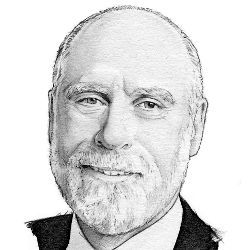
I am on a brief holiday in the U.K. visiting stately homes and manor houses in Cotswolds. If you have never had an opportunity to visit some these incredibly large and elaborate dwellings, you might give it some consideration. What I have found most interesting is the mechanical ingenuity of our 16th– and 17th-century ancestors. At one such mansion, I encountered a clever spit-turner before a huge fireplace driven by gravity. One pulled a weight on a rope up to the ceiling and as the weight dropped, it turned a spit. The tricky bit was to control the rate of descent as to turn the spit slowly. A rather clever gearing arrangement used a small gear to turn a larger one to achieve the desired effect.a Gears were well known by then and used with water wheels and, of course, with clocks.
At the Folger Shakespeare Library in Washington, D.C., there is an exhibit of clocks made by John Harrisonb as well as by others. Harrison is the famous hero of Dava Sobel’s Longitude,c the story of the invention and refinement of the ship’s chronometer. Harrison was in competition with the so-called Lunar Distance method of estimating longitude. Edmund Halley was the Astronomer Royal at that time and strongly encouraged Harrison’s work. After completing three sea clocks (H1–H3), Harrison concluded that a compact watch could perform as well or better. He designed his first sea watch (designated H4 now) and a voyage was undertaken in 1761 aboard the HMS Deptford from Portsmouth to Jamaica and back. The watch performed well but the Board of Longitude complained this might have been sheer luck and refused Harrison the £20,000 prize that had been offered in the 1714 Longitude Act. A second voyage was undertaken to Bridgeport, Barbados with Harrison’s son, William, onboard with H4. Also along on this voyage was the astronomer Reverend Nevil Maskelyne, who carried out the calculations needed for the Lunar Distance method. Both methods worked fairly well but Maskelyne became the Royal Astronomer on return from Barbados and sat on the Longitude Board where he made a very negative report on the performance of the watch. Maskelyne was plainly biased and eventually Harrison turned to King George III for assistance. You must read Sobel’s book or watch the Granada dramatization to learn the rest of the story!
There is so much history and drama hidden in some of the mechanical designs in these ancient buildings. The Protestant Reformation began in 1517 with the publication by Martin Luther of his 95 theses. By the time of Henry VIII, England was still Catholic but owing to the refusal of the Pope to annul his marriage to Catherine of Aragon, Henry persuaded the Parliament to pass the Act of Supremacy in late 1534 declaring Henry the supreme head of the Anglican Church. In 1540, the Catholic Church created the Jesuit Order to battle the protestant movement. Jesuit priests would be spirited across the English Channel to be housed in stately homes of rich Catholic families. By the time of Elizabeth I, it was illegal to practice Catholicism in England and search parties looking for Catholic priests were a regular feature of the time.
Many of the Catholic families had hides built into their homes, spaces to hide priests and others simply to hide valuables. At Harvington Hall, the manor house had many such hiding places.d Some were floorboards that could be tilted to reveal spaces, sometimes stair steps would lift up and in some cases, wall timbers were actually mounted on axles to rotate if you knew where to push. The mechanical inventiveness of these hiding places was notable.
From the Harvington Hall article:
In the late 16th century, when the home became part of a loose network of houses dedicated to hiding Catholic priests, Jesuit builder Nicholas Owen was sent to the building to install a number of secret spots where they could be concealed, should the Queen’s men come calling.
Owen built little cubbies hidden behind false attic walls that could be accessed through a fake chimney; a beam that could flip up on an access point revealing a chamber in the walls (which was only discovered 300 years later by some children who were playing in the house); and, most elaborately, a secret room hidden behind another hidden compartment under a false stair. Smaller compartments to hide the priests’ tools were also built into the floors.
One could go on for many volumes about the rich state of invention in the past. In our computing world, invention is still the coin of the realm, made all the easier by evolving computing and networking platforms of the present.



Join the Discussion (0)
Become a Member or Sign In to Post a Comment